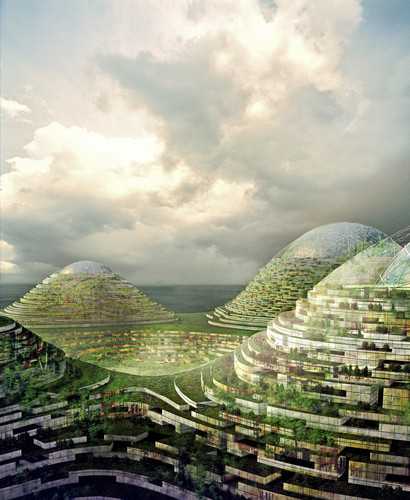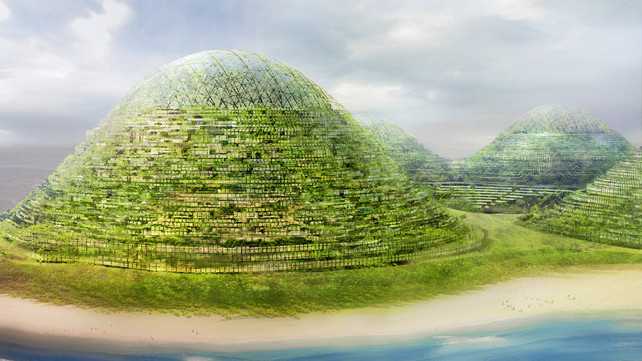Envisioning The City Of The Future As A Man-Made Island

Take an exclusive first tour of Dror Benshetrit’s hilly, floating metropolis for 300,000 residents.
Dror Benshetrit’s body of work is staggeringly diverse. In his studio’s portfolio, you’ll find a hard-shell suitcase that expands like an accordion, a line of modular dorm-room furniture designed for Target, and a proposal for the National Library of Israel that looks like a tall, skinny pyramid some rude giant pushed onto its side. The QuaDror, which Benshetrit unveiled last year, showed the designer’s interest in exploring the most fundamental components of architecture and engineering; it’s a little bit hard to describe, so I’ll defer to Linda Tischler’s explanation of “Ingenious Building Gizmo.” But if the QuaDror showed Benshetrit at his most practical and elemental, his more recent project is a complete 180. HavvAda is Benshetrit’s proposal for a man-made island community off the coast of Istanbul, Turkey, and it’s nothing short of a complete re-imagining of the city as we know it.
For the last 500 years, Benshetrit explained to me, every century or so, someone in Turkey has contrived the construction of a new canal between the Black Sea and the Sea of Marmara. The latest dreamer is Turkish Prime Minister Recep Tayyip Erdoğan, whose proposed Istanbul Canal foreesees completion sometime around 2023. Building such a massive waterway would require digging up a massive amount of dirt–in this case, somewhere in the ballpark of a billion cubic meters of the stuff. Where would it all go? That’s precisely what a developer commissioned Benshetrit to figure out.
His answer is HavvAda, a man-made island comprised of six hills of varying sizes, each supported by a geodesic dome with residential homes on their outside and communal and commercial spaces on the inside. These six “micro-environments,” as Benshetrit calls them, surround a valley intended for parks and other recreational spaces. From a distance, as seen in the renderings, the island straddles the line between organic and artificial–HavvAda’s hills are a little too perfectly sculpted to be natural, but they’re certainly more pleasing to the eye than, say, six big apartment complexes.
One possibility that arises from the island’s arrangement is a move to an entirely new form of urban model: a 3-D grid, as opposed to the 2-D one on which our cities currently operate. Instead of reaching up into the sky vertically, buildings wrap around the domes horizontally. The idea is that, in addition to being more structurally efficient, the domes would share infrastructure. With a 3-D grid, Benshetrit said, “instead of each being a selfish, independent building, all the buildings are supporting one another in both structure and infrastructure.”
The 3-D grid is just one of the ways HavvAda looks to solve some of the problems faced by sprawling metropolises. “Istanbul is a gorgeous city,” Benshetrit said, “but it’s suffering from the same problem that every large, dense, multimillion- resident city has today: enormous traffic, crazy pollution. It’s just a concrete jungle, as we call most of our cities at that scale.” In creating HavvAda, Benshetrit worked with a team of architects, urban planners, engineers, and other experts to identify these central issues and explore some bold ways to solve them. But in addition to loftier goals like sustainability, HavvAda also was designed to alleviate some of the day-to-day frustrations of city living. Ideally, Benshetrit explained to me, you should be able to get from any point in a city to any other point in 12 minutes. One of the advantages of arranging the six domes around a common center area is that such movement throughout the island becomes feasible; HavvAda’s proposed transportation includes a system of walkways and cable cars. Granted, HavvAda would only be about a quarter of the size of Manhattan and hold some 300,000 people, making it a more manageable urban scenario from the start.
Benshetrit’s quick to admit that HavvAda is more about offering a vision than putting forward a nuts-and-bolts plan of action–he deems it an “evolving proposal”–and he says that one can only go so far in prescribing the form that vision might eventually take. When you’re designing a product or even a single building, he explained, you go into it with some sense of what it will look like, what sort of details you need to consider in its creation. HavvAda is a bit different. “It’s not a full product,” he said, “it’s just a canvas, a motherboard for other designers and other architects to make different storefronts, different types of structures, to make different types of gardens and paths and things like that.” It’s not really the city of the future; it’s more like a blueprint for one. Still, not bad for a big pile of dirt.
HavvAda will debut this weekend during the kickoff of Istanbul design week.

via 1 | Envisioning The City Of The Future As A Man-Made Island | Co.Design: business + innovation + design.